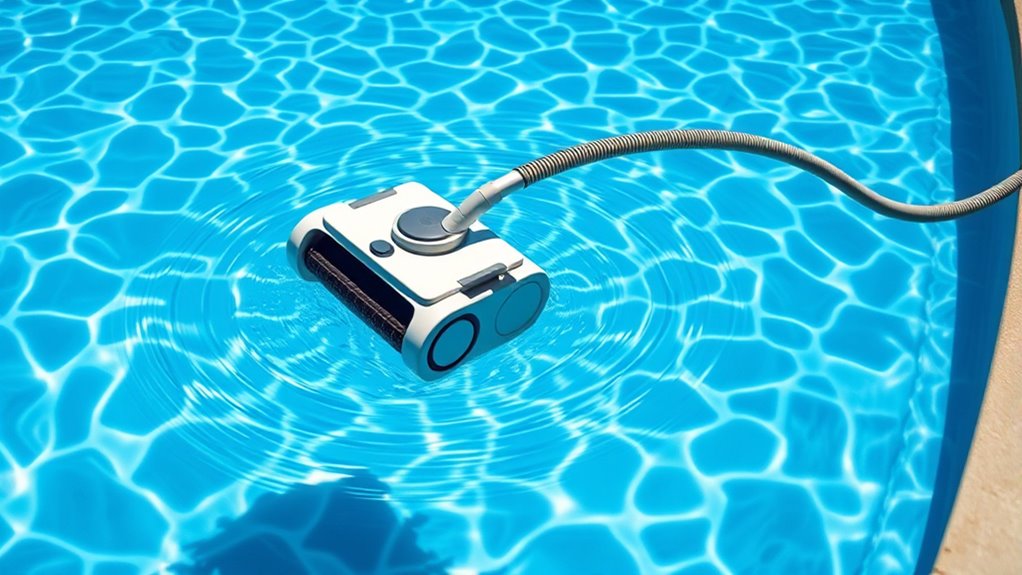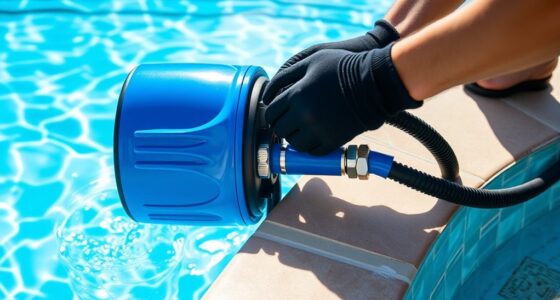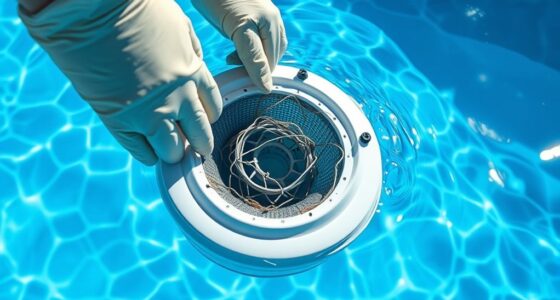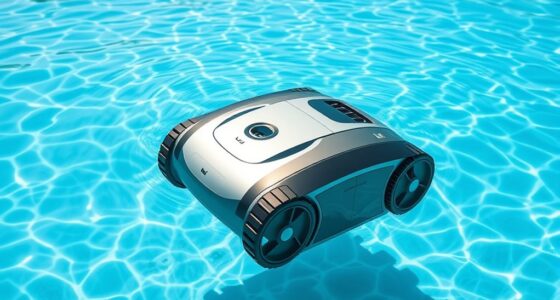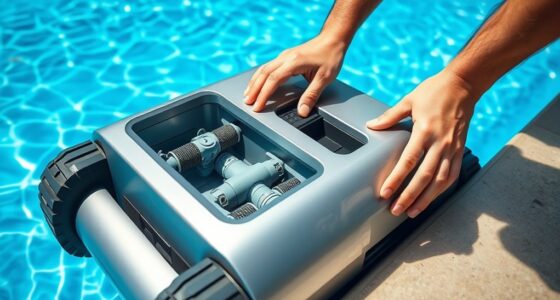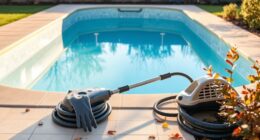To maximize your suction pool cleaner’s efficiency, start by clearing the pool of obstacles, debris, and ensuring water chemistry is balanced. Adjust suction and filter settings for ideal flow, and position the cleaner near high-traffic areas. Regularly inspect and maintain hoses, brushes, and filters, and consider customizing movement patterns for thorough coverage. Using the right accessories and scheduling cleanings during off-peak times can boost performance—keep going to discover more expert tips.
Key Takeaways
- Regularly inspect and clean the pool and cleaner components to prevent blockages and maintain optimal performance.
- Adjust suction and filter settings based on debris load and pool size for efficient cleaning.
- Position the cleaner strategically in high-traffic areas and clear obstacles to improve coverage.
- Maintain proper water chemistry to enhance cleaner efficiency and prolong device lifespan.
- Schedule routine maintenance, including filter cleaning and wear checks, to ensure consistent operation.
Prepare Your Pool and Cleaner Before Use

Before using your suction pool cleaner, you should thoroughly prepare both the pool and the device. Ensuring pool safety is your top priority, so remove any obstacles or debris that could hinder the cleaner’s operation or cause damage. Check that the equipment is compatible with your pool’s size and shape to prevent inefficiency or malfunction. Inspect the cleaner for any damage or blockages, and make sure the hoses are securely connected. Clear the skimmer and pump baskets to maintain proper suction. Confirm that the pool’s water level is adequate—usually at least halfway up the skimmer opening. Proper preparation not only enhances cleaning performance but also promotes safety, reducing risks of equipment failure or accidents during operation. Additionally, understanding the importance of filtration systems can help you evaluate how well your pool cleaner captures debris and maintains water clarity, which is crucial for a clean and healthy swimming environment. Regularly checking your filtration system ensures optimal water circulation and debris removal, further enhancing your cleaning efficiency. To maximize your pool cleaner’s effectiveness, it’s also beneficial to consult your manufacturer’s instructions to ensure correct setup and operation.
Ensure Proper Suction and Filter Settings

To guarantee your suction pool cleaner works effectively, you need to verify that the suction and filter settings are properly adjusted. Correct suction power ensures the cleaner moves efficiently without stalling or missing spots. Proper filter settings prevent debris from clogging the system and improve suction. Regularly inspecting and maintaining your system can also prevent false alarms and ensure optimal performance. Additionally, monitoring the best anime movies can provide relaxing entertainment during maintenance breaks. Here are three key tips:
- Adjust the suction control valve to match your pool’s size and debris load, ensuring ideal suction power.
- Check that the filter is clean and properly seated to maximize flow and filtering efficiency.
- Set the cleaner’s flow rate to prevent loss of suction or overexertion, maintaining consistent cleaning performance. Remember, maintaining proper filter settings can also extend the lifespan of your cleaner and improve overall efficiency.
Clear the Pool of Debris and Obstacles
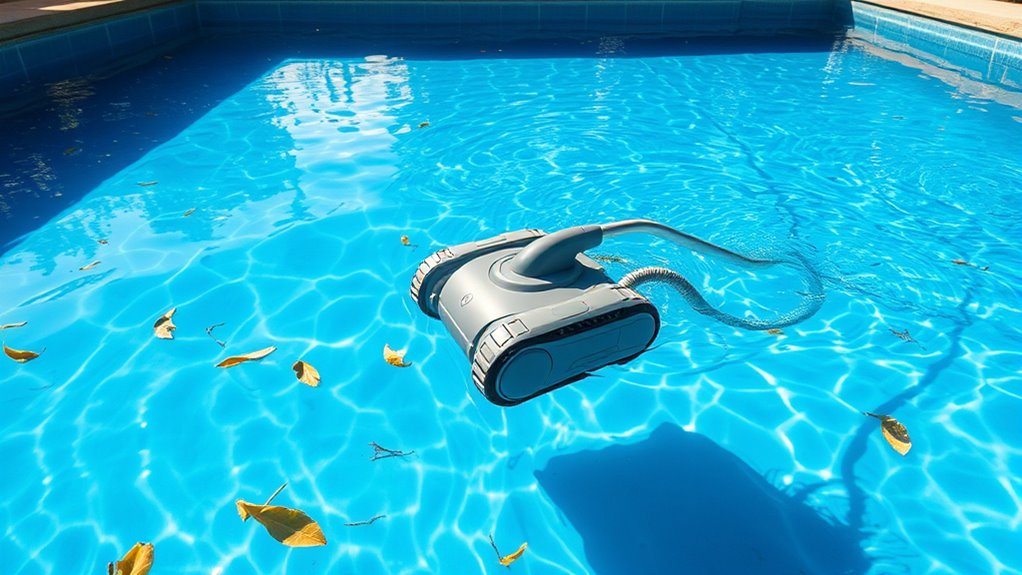
Start by removing any loose debris, leaves, and obstacles from the pool’s surface and bottom. This includes sweeping away floating debris and clearing out larger objects that could clog or obstruct your cleaner. If you use a pool cover, verify it’s fully removed beforehand to prevent debris from falling in during cleaning. Additionally, perform underwater obstacle identification by inspecting for toys, pool tools, or other items that could hinder the cleaner’s movement. Clearing these obstacles allows your suction pool cleaner to operate smoothly and cover the entire pool efficiently. Keeping the pool free of debris and obstacles to prevent tangling or blockages, which can reduce cleaning effectiveness and strain your equipment. A clean, obstacle-free pool helps maximize your cleaner’s performance. Remember that a well-maintained, properly balanced pool environment can also contribute to more efficient cleaning results. Regularly checking and maintaining your pool’s water chemistry ensures optimal filter performance and prolongs the lifespan of your cleaning equipment. Additionally, maintaining proper water chemistry can help prevent scale buildup that might impair your cleaner’s operation. To further improve cleaning efficiency, consider inspecting the pool equipment regularly for any issues that could affect performance. Moreover, ensuring that the drainage system is functioning properly can help prevent water stagnation that might hinder the cleaner’s movement.
Position the Cleaner Strategically for Optimal Coverage

Positioning your suction pool cleaner correctly can make a significant difference in its efficiency. Strategic positioning ensures better coverage optimization, saving you time and effort. To maximize effectiveness, consider these tips:
Proper placement boosts your pool cleaner’s efficiency and saves time.
- Place the cleaner near high-traffic areas like stairs or the main drain to target debris where it settles.
- Position it along the pool’s perimeter to cover edges and corners thoroughly.
- Avoid obstacles that could hinder movement; clear the way to allow smooth navigation.
- Adjusting the cleaner’s pressure settings can improve its ability to maneuver and clean more effectively.
- Regularly inspecting and maintaining the cleaner ensures optimal performance and prolongs its lifespan, especially when proper maintenance is performed.
- Being aware of the advancements in automation can help you select models with enhanced features for better cleaning coverage.
- Understanding the divorce process and requirements can help you manage legal matters efficiently should your circumstances change.
- Staying informed about AI detection methods can help you troubleshoot and optimize your cleaner’s detection of debris and obstacles.
Adjust the Cleaner’s Path and Movement Patterns

Adjusting your cleaner’s path and movement patterns is essential for thorough coverage. If your cleaner relies on random movement, it may take longer to clean the entire pool. To improve efficiency, switch to a zigzag pattern, which guarantees consistent coverage and prevents missed spots. You can manually guide the cleaner along the pool’s length or set it to follow a specific pattern if your model allows. Regularly changing the direction or pattern prevents the cleaner from getting stuck or repeatedly cleaning the same area. Keep in mind, a well-planned movement pattern minimizes missed debris and reduces cleaning time. Incorporating jet propulsion technology into your routine can also inspire creative ways to personalize your equipment and accessories, adding a fun touch to your cleaning setup. Additionally, understanding cleaning cycle duration helps in optimizing the operation and ensuring your pool is cleaned efficiently. Knowing how tuning can enhance your pool cleaner’s performance allows you to customize it further for better results. For example, selecting the right storage conditions can help maintain your cleaner’s components and prolong its lifespan. By actively managing the cleaner’s path, you maximize the cleaner’s effectiveness and keep your pool sparkling clean with less effort.
Regularly Inspect and Maintain the Cleaner

To keep your cleaner working efficiently, you need to regularly check for signs of wear and tear. Make sure to clean the filter often so it doesn’t clog and reduce suction. After use, store it properly to prevent damage and guarantee it’s ready for your next pool cleaning. Regular maintenance ensures the airless sprayer performance remains in optimal condition and extends its lifespan.
Check for Wear and Tear
Regularly inspecting your suction pool cleaner for signs of wear and tear guarantees it functions efficiently. Over time, component degradation can reduce cleaning power and cause malfunctions. To keep it in top shape, check for:
- Cracks or holes in hoses and seals that might lead to leaks.
- Worn brushes or impeller blades that affect debris pickup.
- Loose or damaged connections that could impair suction performance.
Addressing these issues promptly prevents further damage and ensures your cleaner operates smoothly. Pay close attention to any unusual noises or reduced movement, which often indicate wear and tear. Regular inspections help catch minor problems early, extending the lifespan of your device and maintaining excellent cleaning efficiency. Remember, proactive maintenance saves you time and money in the long run. Additionally, understanding air quality can help you identify if your pool environment requires extra filtration or cleaning measures. For optimal operation, it’s also beneficial to review component durability, as certain parts may need replacement sooner depending on usage conditions.
Clean Filter Regularly
Keeping your suction pool cleaner in top shape means not only checking for wear and tear but also ensuring the filter stays clean. Regular filter maintenance is essential for peak performance. You should inspect the filter basket frequently and remove any debris buildup to prevent clogs. Debris removal improves suction power and helps the cleaner operate efficiently. When cleaning the filter, rinse it thoroughly with a garden hose to eliminate dirt and particles. Avoid neglecting this step, as a dirty filter reduces suction and strains the motor. Establish a routine schedule for filter cleaning, especially during heavy use or after storms, to keep your cleaner running smoothly. Proper filter maintenance ensures consistent cleaning and prolongs the lifespan of your suction pool cleaner.
Store Properly After Use
After each use, inspecting and maintaining your suction pool cleaner guarantees it stays in good condition. Proper storage is key to prolonging its lifespan and ensuring ideal performance. Follow these storage tips to keep your cleaner in top shape:
- Rinse the cleaner and its parts with fresh water to remove any dirt or debris.
- Check and clean the filters and brushes with your cleaning supplies before storing.
- Store the cleaner in a cool, dry place away from direct sunlight, preferably hanging or on a shelf to prevent damage.
Optimize Your Pool’s Water Chemistry for Better Performance
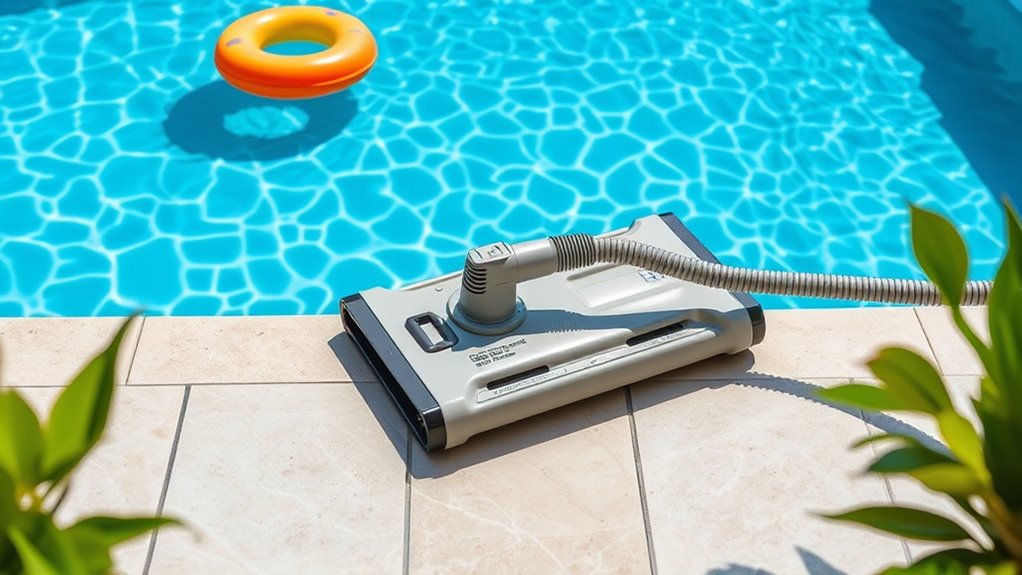
Keeping your pool’s water chemistry in check is key to improving your cleaner’s performance. You should regularly balance the pH levels and guarantee proper chlorination to prevent debris buildup and algae growth. When the water chemistry is just right, your suction pool cleaner works more efficiently and lasts longer.
Balance Ph Levels
Have you checked your pool’s pH levels lately? Proper pH balancing is essential for your suction pool cleaner to perform at its best. When pH levels are in the right range, your pool’s water chemistry stays in chemical harmony, preventing buildup and ensuring efficient cleaning. To maintain ideal pH levels, consider these tips:
- Test your water regularly with a reliable kit to catch imbalances early.
- Add pH increasers or decreasers as needed, following manufacturer instructions precisely.
- Keep an eye on total alkalinity, as it influences pH stability and overall water balance.
Maintain Proper Chlorination
Are you guaranteeing your pool stays properly chlorinated? Maintaining correct chlorine levels is essential for effective sanitization routines and preventing algae or bacteria buildup. Regularly test your water using a reliable tester, aiming for a chlorine level of 1-3 ppm. If levels are too low, add chlorine to boost sanitization; if too high, dilute with fresh water. Consistent chlorination keeps your pool safe and reduces the workload for your suction pool cleaner. Proper chlorination also prevents cloudiness and unpleasant odors, helping your pool stay clear and inviting. Incorporate routine checks into your maintenance schedule, especially after heavy usage or storms. By keeping your chlorine levels balanced, you guarantee optimal water quality and maximize your pool cleaner’s performance.
Use the Right Attachments and Accessories
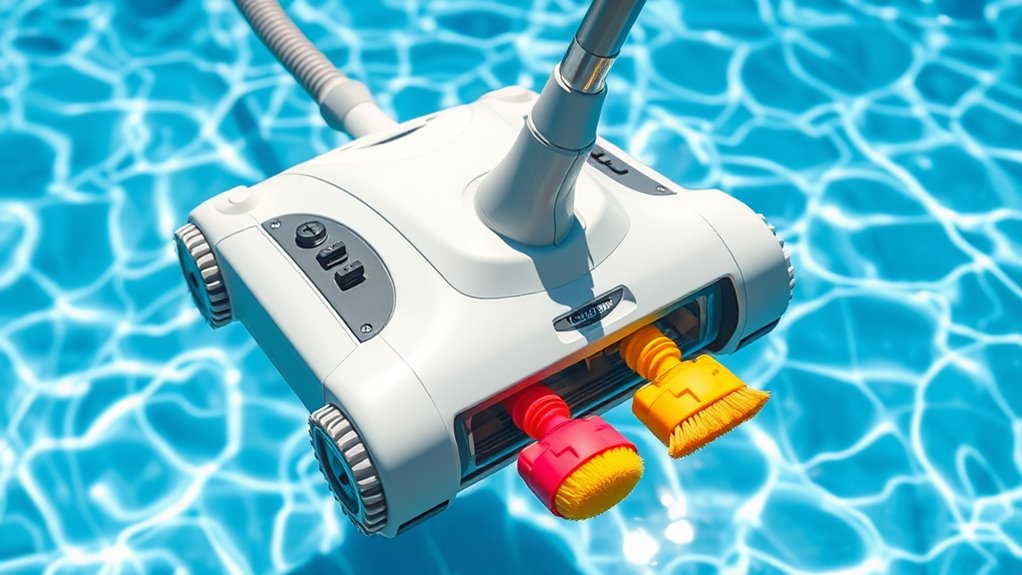
Using the right attachments and accessories can make a significant difference in the efficiency of your suction pool cleaner. Choosing the proper attachment options guarantees you target specific debris and surfaces effectively. Always check accessory compatibility with your cleaner model to avoid fitting issues. Here are some key points:
- Select brushes or scrubbers suitable for your pool surface to improve debris removal.
- Use specialized skimmers or vacuums for leaves or fine particles.
- Ensure accessories are compatible with your cleaner’s attachment port to prevent leaks or detachment.
Matching the right accessories with your cleaner maximizes cleaning power and saves you time. Regularly switch attachments based on pool conditions for optimal results. Proper accessory choice enhances overall efficiency and prolongs your cleaner’s lifespan.
Schedule Cleaning Sessions for Maximum Efficiency
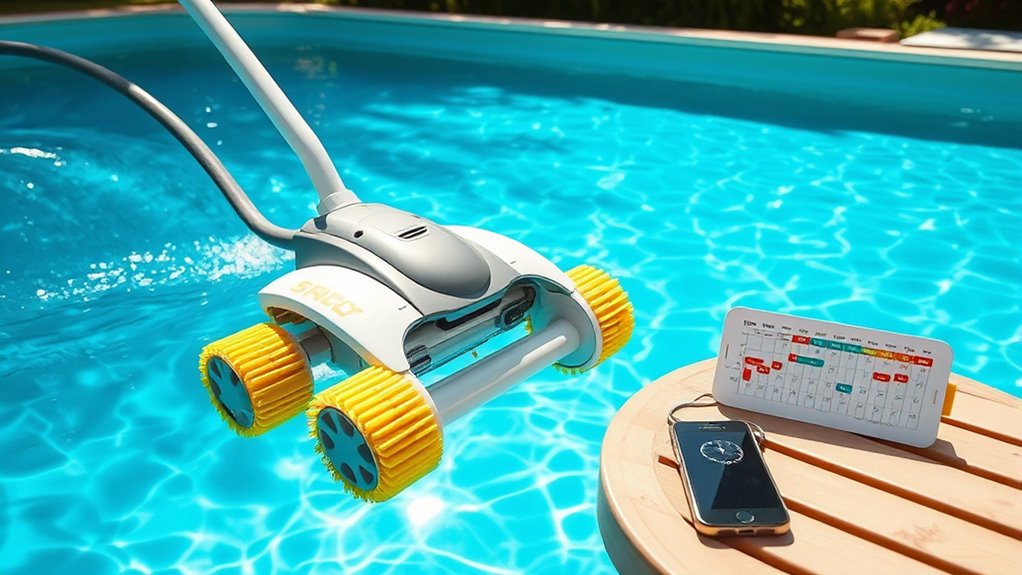
Scheduling your pool cleaning sessions strategically guarantees your suction cleaner operates at peak efficiency. Consider timing considerations—running the cleaner during off-peak hours or when the pool is less used to make certain better cleaning results and reduces strain on the motor. Seasonal scheduling is also key; during peak swimming seasons, clean your pool more frequently to handle increased debris, while in winter, reduce cleaning sessions to save energy. Regularly analyze your pool’s usage and debris levels to adjust your schedule accordingly. Avoid running your cleaner during heavy wind or rain, which can overwhelm it with debris. By planning your cleaning sessions thoughtfully, you maximize performance, prolong your cleaner’s lifespan, and keep your pool sparkling all season long.
Frequently Asked Questions
How Often Should I Run My Suction Pool Cleaner for Best Results?
You should run your suction pool cleaner about 2-3 times a week for ideal results. This frequency helps maintain cleaner maintenance and keeps your pool spotless. Running it too often can increase energy consumption unnecessarily, while too little use may lead to debris buildup. Monitor your pool regularly, and adjust the cleaning schedule based on usage, weather, and debris levels to guarantee efficiency without wasting energy.
Can I Leave the Cleaner in the Pool Overnight?
Imagine a pool owner who leaves their suction cleaner overnight. While it might seem convenient, for pool maintenance, it’s better to remove and store the cleaner properly. Leaving it in the pool can cause wear and reduce efficiency. Plus, it could clog filters or cause damage. To keep your cleaner in top shape, store it dry and in a safe place when not in use, rather than leaving it submerged overnight.
How Do I Troubleshoot if the Cleaner Gets Stuck Frequently?
If your suction pool cleaner gets stuck often, start troubleshooting by manually adjusting its position and checking for obstructions. Inspect the hose thoroughly for kinks, leaks, or blockages that might hinder movement. Make sure the hose is properly connected and floating freely. Sometimes, slight manual adjustments or replacing damaged sections can improve navigation, preventing frequent getting stuck and ensuring more efficient cleaning.
What’S the Ideal Pool Size for a Suction Cleaner?
The ideal pool size for a suction cleaner depends on the cleaner’s capacity and your pool’s dimensions. Smaller pools, up to 20,000 gallons, typically work well with standard suction cleaners, ensuring better cleaner efficiency. Larger pools may require more powerful or multiple cleaners to cover the area effectively. Knowing your pool size helps you choose the right cleaner, ensuring it operates efficiently without frequent getting stuck or missing spots.
Are There Specific Pool Shapes That Are Harder for Suction Cleaners?
Did you know that 60% of pool owners find certain shapes more challenging? Pool shape challenges, like irregular or kidney-shaped pools, can hinder cleaning coverage because suction cleaners struggle to reach all corners evenly. You might notice missed spots or uneven cleaning, especially around tight curves or narrow passages. To improve coverage, consider manually guiding the cleaner or adjusting its path, ensuring every nook gets thoroughly cleaned regardless of your pool’s unique shape.
Conclusion
By following these tips, you’ll turn your suction pool cleaner into a powerhouse that makes your pool sparkle like a crystal. With a little prep and regular maintenance, you’ll breeze through cleaning sessions and enjoy crystal-clear water without breaking a sweat. Think of your cleaner as your secret weapon—an unstoppable force that transforms your pool into a shimmering oasis in record time. Get started today and watch your pool stay flawless like never before!
